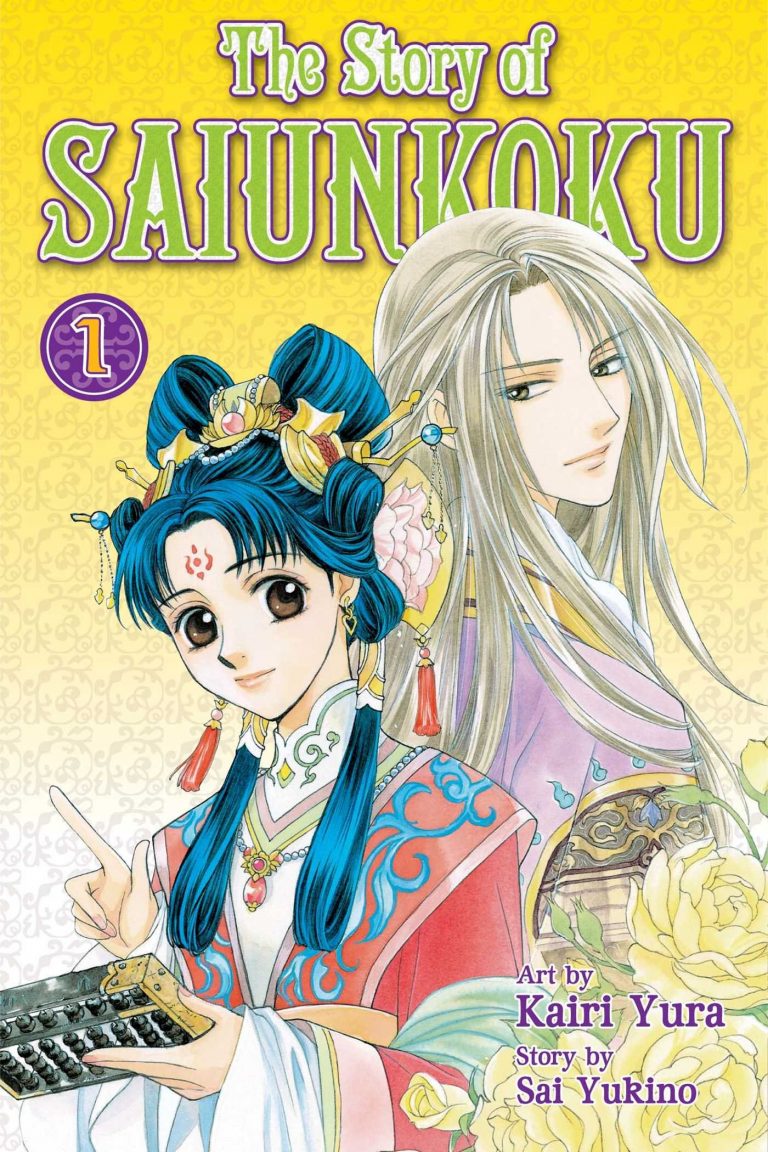 Title: Saiunkoku Monogatari (The Story of Saiunkoku; The Tale of the Kingdom of Colored Clouds | )
Title: Saiunkoku Monogatari (The Story of Saiunkoku; The Tale of the Kingdom of Colored Clouds | )
Author: Sai Yukino (story); Kairi Yura (art)
Genres: Romance, Drama, Historical, Political, Comedy, Reverse Harem
Published: 2003 – 2011 (LN); 2005 – 2012 (manga)
Volumes: 18 (LN – complete); 9 (manga – defunct)
Japanese Publisher: Monthly Asuka (magazine); Kadokawa Shoten (tankobon format)
English Publisher: Viz Media (albeit rights have now been transferred to Yen Press)
Available to Purchase in English?: Yes (Amazon / Barnes & Noble / Indigo)
[Note: This post contains mild spoilers]
Finally, for those of you who’ve been wondering about my repeated references to this series, I’m going to explain to you why I love SaiMono so much.
But first a quick explanation for all the parentheses in the summary. Saiunkoku Monogatari is something of an incomplete series. In Japan, there are the light novels (x 18, plus four volumes of side stories), two seasons of anime, and nine manga. However in North America, fans have access to… one season of anime and the manga. -_- Furthermore assuming that it was due to declining sales and interest in the series, only the nine volumes of manga were ever created, leaving the equivalent of the second half of the first season and all of the second of the anime untold in manga format. So basically if you can’t read Japanese fluently and aren’t able to import the light novels, as a fan you’re hooped when it comes to reading the full story yourself.
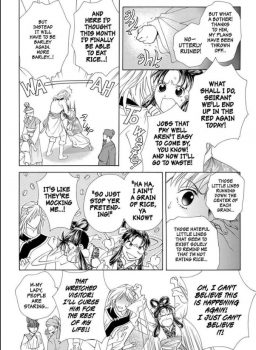
Also in my review of A Bride’s Story, I mentioned that it narrowly beat out Saiunkoku Monogatari as my favourite series, but in retrospect I think I meant that more in terms of the artwork. Both series are gorgeous, however overall I think I prefer the story of SaiMono. It’s very close though!
Alright, onward to the meat of my review.
Saiunkoku Monogatari centers around a sixteen year old girl named Shuurei Kou (as in the original Japanese media). She is from one of the eight noble families of Saiukoku, but her immediate family has little money and so she and her family’s retainer, Seiran Shi, have to work assorted odd jobs in order to help her father make ends meet. Shuurei’s father found Seiran abandoned one night when he was young and Shuurei was still small, so he works for Shuurei’s father in an effort to repay the kindness shown to him. Shuurei’s father Shouka works in the Imperial Archives but makes little money, and Shuurei’s mother passed away when Shuurei was little, so her family has few options left when it comes to surviving short of begging their relatives for money.
At the beginning of the series, Shuurei is approached by one of the Emperor’s Grand Advisors who has a proposition for her. The current Emperor, Ryuuki Shi (different kanji, but…), wants nothing to do with royal duties and has been shirking his responsibilities. If Shuurei is willing to enter the imperial household and spend six months as the emperor’s consort teaching the emperor how to be a strong ruler, with Seiran going as her bodyguard, Advisor Sho will give Shuurei’s family a very large sum of money. Shuurei is desperate and agrees to the deal, realizing only later that she might be in over her head.
However the arrangement is bittersweet. From the time when the country of Saiunkoku was struck by extreme poverty and hardship, Shuurei’s dream has been to become an official in the Imperial Court so she can help others. But there’s a catch – women are forbidden from taking the exams. So being in the Inner Court is a little like rubbing salt in a wound for Shuurei, but she is still determined to teach Ryuuki to be a good emperor. Ryuuki is of course attracted to Shuurei, but she is unbelievably sheltered and naive when it comes to the opposite sex, and she rebuffs his advances.
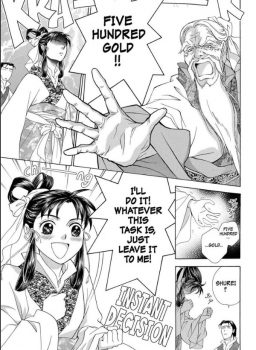
After Shuurei finishes her time with Ryuuki and leaves the Imperial Palace, Ryuuki decides that he will change the laws so that women are able to take the entrance exams. With the door to her dream now accessible for the first time in her life, Shuurei takes up the challenge.
There’s so much more I could say but don’t want to get into because I don’t want to spoil this amazing series for anyone, so all I can say is to GO READ IT and GO WATCH IT because it’s a one-of-a-kind series you won’t forget.
So, pros? Fantastic characters, tons of bishounen in a reverse harem, a unique story, and gorgeous artwork elevate this series above others for me. And as I’ve said before, as much as I hate the term “strong female character”, this series has several. Shuurei herself is a fantastic role model, for reasons I’d be happy to get into if anyone wants to have that discussion.
What else? There’s romance but the series doesn’t revolve around it; in fact because of Shuurei’s aversion to men, what romance there is ranks a little lower on Saiunkoku Monogatari‘s scale of important factors, a nice change in an industry where many series are near carbon copies of the same damn thing because creators know that that’s what sells. And it’s a historical title, so there is little nudity or over-the-top innuendo, something I consider to be a breath of fresh air. Politics are front and center in Saiunkoku Monogatari too.
I’d like to take a moment to comment on the depth of Saiunkoku Monogatari. There are so many layers, so many hidden things and plays on words which are expertly woven together to create a detailed story. Names, character relationships, ulterior motives – ugh. I don’t even know how to put it into words because I don’t want to ruin it for anyone, but I’m honestly hard-pressed to think of a series which has the richness and complexity of Saiunkoku Monogatari. There’s just so much to it; it’s not just some straightforward historical romance.
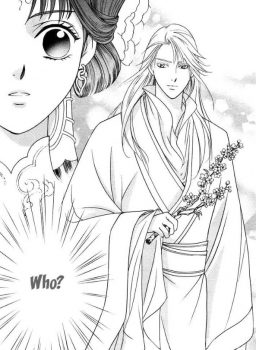
Cons? The series is extremely slow-paced. How slow? Both seasons of anime have 39 episodes. Each. Whew! So there’s lots of plot, but there’s also lots of filler. Plus towards the end of the second season I found the story got a little convoluted and farfetched, though overall I feel it still stands strong. In terms of the manga (since this is a manga review, not an anime review >>; ), only the first two or three story arcs are covered, enough to get the reader interested but then left wanting more.
If you’re reading or watching Saiunkoku Monogatari for lots of romance, you might be disappointed. Don’t get me wrong there’s definitely romance in Saiunkoku Monogatari, but it’s often subtle, and the obvious moments are infrequent. Plus you know, there’s the whole reverse harem factor to contend with if that’s not your thing.
Lastly as I already mentioned, the series is incomplete. If you finish the second season of the anime, you can see how it was left open for a continuation, but due to decreased popularity I don’t think we will ever see a third season, or more of the manga. o(╥﹏╥)o
My Score: 9/10
Do I Recommend This Title?: If you can tolerate slow-paced series, then YES, if only for the artwork and the characters. There are so many layers to Saiunkoku, much of which is not revealed until much later, and though the manga is incomplete I still feel like it’s a title worth reading. It’s like a beautiful onion – pretty to look at as a whole, but as you get further down through the layers it’s going to make you cry.
And if you ever want to talk about this series AT ALL, please feel free to ask me about it! I literally will never tire of talking about Saiunkoku Monogatari. (ノ◕ヮ◕)ノ*:・゚✧
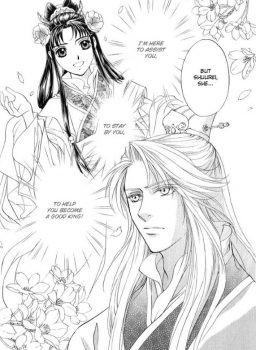
I liked the anime series, however, was cheesed that the ending was left open – I mean after watching that many episodes, you’d think they’d give us, if not the LN/manga ending, at least an anime original ending, rather than the usual “well, unless you can read Japanese, no closure for you, suckers!” that we’ve had to endure from other, shorter anime.
I did find out from other sources what happened in the end, but won’t say here.
YES, I thought the same thing. I wonder if they hadn’t known by the beginning of the second season that there wouldn’t be a third?
For example, Vampire Knight did an anime-original ending, because it aired while the manga was still being published, and while I don’t like the anime ending it is at least an ending as you said.
Ugh, don’t even get me started on how SaiMono ended. I remembering reading the summary of the final light novel online and being so upset about a certain Kou princess. ;~;
Are we thinking of the same ending? The ending I read was sad, but it satisfied me, as in a “well, that’s that, and there’s nothing more.”
Not sure? I heard that the final light novel contained an epilogue of sorts to the series, ie what happened to all of the characters. I think that’s where it was included anyways. So my comment was referring to the last light novel, not the anime.
Okay, then we did read the same summary. The ending made me think, “darn, too bad, but that’s life.”
The character names are how the Japanese read Chinese characters, but they have their corresponding pinyin pronounciations as Chinese people follow. For example, Shi Ryuki = 紫 劉輝 = Zǐ Liúhuī. Kou Shuurei = 紅 秀麗 = Hóng Xiùlì.
Try plug other names into Google Translate, and you’ll get the same results.
I apologise. This is what I had been referring to. From Wikipedia:
“In the original Japanese media, the name of this clan and family is pronounced as Kō. By the request of Saiunkoku’s original creator, Geneon changed this name in the official North American version to “Hong”, the Mandarin Chinese pronunciation of the same logogram, in order to minimize confusion with the other “Ko” name belonging to the Yellow clan/province. Funimation has retained this name change in its distribution of the Geneon DVDs.”
Sorry, I should have been clearer about my reference to the subtitles.